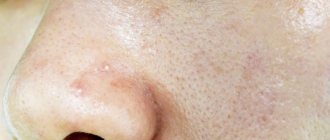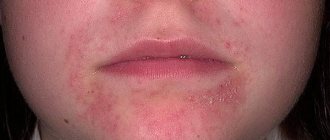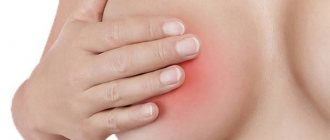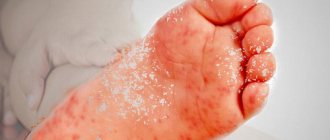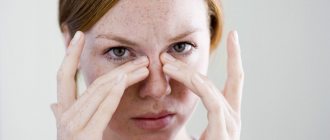A common disease of immune origin, manifested as inflammation of the walls of the capillaries of the skin and internal organs, is hemorrhagic vasculitis. This is an aseptic pathology, which is characterized by the active formation of immune complexes and damage to the wall of microvessels with an increase in their permeability. The disease is systemic in nature and affects people at any age, but the largest number of patients are among children and adolescents aged 4 to 12 years. Boys get sick 2-2.5 times more often than girls.
What is a hemorrhagic rash?
When the capillaries are damaged, some of the red blood cells come out of the vessel, which leads to the appearance of a rash with red spots - this is a hemorrhagic rash.
Initially, the rash is painless, but if you ignore the rash, it may become painful. When you press on the rash, its color does not change in any way, and the rash does not become smaller. This is the hallmark of hemorrhagic rashes.
Depending on the lesion that caused the rash, the types of rashes can be different - small dots, stripes or spots, the color of which can also be varied - blue, red, purple. The size of the spots may vary. In medical practice, medium-sized spots are usually called liver purpura , and small spots are called petechiae.
Features of hemorrhagic rash in children
A hemorrhagic rash in children usually accompanies hemorrhagic vasculitis, hemophilia, meningococcemia, and thrombocytopenic purpura. But hemorrhagic vasculitis is the most common disease, the manifestation of which is a rash.
As already mentioned, the most common manifestation of the rash occurs on the front surfaces of the legs. However, it can also be localized on the torso, buttocks, and thighs. The rash is located symmetrically, does not disappear when pressed and does not change its color. The disease usually affects children under six years of age.
In addition to hemorrhagic rashes, other types of rashes also occur in children. In the article on the website you can see a photo of a rash on a child’s body with explanations.
Folk remedies
Instead of medications, you can use folk remedies. Garlic oil helps to cope well with any type of rash. You can use a decoction of oak bark for baths. This procedure helps speed up the healing process and also has a beneficial effect on the body.
To treat the affected area and make the skin shiny and smooth, it is recommended to use a decoction of barley grain.
Typical localization of hemorrhagic rash
Photo
The most common place for hemorrhagic rashes to occur is the legs.
However, the rash can also appear on other areas, for example, as shown in the picture below, on the face:
Photo
The rash, when it appears on the legs, is usually localized not on the front surface, and has a fairly symmetrical pattern, as can be seen in the photo:
Photo
But there are often cases when a rash on the body appears on the thighs or buttocks:
Possible complications
Timely treatment contributes to the favorable course of the disease, and with proper therapy there are no scars left. But if you start the process of this disease, as well as in case of improper treatment, dangerous complications can arise:
- pulmonary hemorrhage;
- formation of diathesis;
- intestinal obstruction;
- disorders of the liver, heart and kidneys;
- peritonitis.
Dangerous complications can be caused by corticosteroid drugs, which are analogues of the hormone cortisol. If its level increases, pathological processes begin to occur in the body. It is possible to develop such disorders as:
- insomnia and mood swings;
- exacerbation of ulcers and gastritis;
- increased blood pressure;
- weight gain in certain parts of the body;
- swelling and fluid retention in the body;
- osteoporosis.
The greatest danger comes from damage to the bone marrow, since it is the bone marrow that is involved in the process of formation of blood cells. To monitor this process, you need to undergo tests periodically. It is important to follow preventive measures. A healthy lifestyle, proper nutrition, giving up bad habits, and maintaining a work and rest schedule help eliminate many diseases. It is also extremely important to monitor your health and the well-being of your loved ones, especially if there are small children in the family.
Types of hemorrhagic rash
The division of the rash according to general rules is divided into primary and secondary elements. Spots that appear on unaltered areas of the skin, that is, not exposed to any diseases, are classified as the primary element of a hemorrhagic rash. The evolution of such spots is a secondary element of the rash.
The primary element is divided into cavity or cavityless. Hemorrhagic type rashes are classified as non-inflammatory processes, since pressing on the spot does not contribute to its disappearance or change, while inflammatory spots first disappear and then reappear.
Depending on the size, hemorrhagic rash is divided into three types:
- petechiae;
- purpura;
- ecchymosis.
The smallest rash, which looks like a simple dot, is called petechiae. Purples are slightly larger in size, measuring about 3 mm in diameter and have a round shape. Ecchymoses, in turn, are the largest spots of the hemorrhagic type. They have an irregular shape and exceed 5 mm in size.
In any situation, the occurrence of a hemorrhagic rash is caused by an increase in the permeability of the walls of blood vessels, a violation of the integrity of these walls under the influence of toxins, injuries, and metabolic disorders.
Other treatments
In addition to prescribing medications, therapy can be carried out using other methods:
- pulse therapy;
- Acellbia;
- plasmapheresis.
Pulse therapy involves the administration of large amounts of corticosteroids. The medicine is used in critical cases when it is necessary to urgently eliminate the inflammatory process occurring in the vascular area.
Plasmapheresis is characterized by the fact that using a special device, blood is taken, which is then cleared of aggressive immune cells and returned back to the bloodstream. During the procedure, plasma is removed along with substances that provoke inflammation and some aggressive immune cells. This is one of the most effective methods of therapy, but it is short-term, which means it cannot replace taking medications. Used only in critical cases.
Acellbia involves the administration of antitumor drugs that destroy cells produced by antibodies. As a result, the activity of the immune system decreases. Such drugs have a more gentle effect compared to corticosteroids and cytotoxic agents.
Causes of hemorrhagic rash
The causes of any rash are either a disease occurring in the body or an allergic reaction. Hemorrhagic rash is a symptom of many different diseases, and in each case requires immediate medical attention.
Most often, the manifestation of hemorrhagic rash accompanies diseases such as:
- hemorrhagic vasculitis;
- malaria;
- typhoid fever;
- meningococcemia;
- sepsis;
- septic forms of plague and anthrax;
- scarlet fever;
- staphylococcal infections.
Hemorrhagic vasculitis
Hemorrhagic vasculitis is an acquired disease. It is caused by inflammatory damage to the blood vessels of the skin, gastrointestinal tract and kidneys, which causes increased bleeding. If we talk about the risk group, the disease affects both men and women equally.
If we talk about age categories, you can get vasculitis at any age, however, the disease most often occurs in children aged four to twelve years . Vasculitis is caused by a previous infectious disease, for example, tonsillitis, ARVI, scarlet fever. The first symptoms of vasculitis appear from one to four weeks after suffering from an infectious disease.
You might be interested! Body louse: what kind of parasite is this and how to get rid of it?
In some situations, the onset of the disease is preceded by:
- vaccination;
- allergic reaction;
- drug intolerance;
- previous injuries;
- hypothermia of the body.
All signs of vasculitis are divided into several types:
- skin syndrome;
- articular syndrome;
- abdominal syndrome;
- renal syndrome;
- anemic syndrome;
- other symptoms.
Skin syndrome is characterized by the appearance of small hemorrhages localized on the surfaces of the skin.
Such hemorrhages are located:
- near joints, especially legs;
- on the hands and feet;
- on the skin of the thighs;
- on the buttocks;
- on the skin of the face;
- on the body.
Disappeared hemorrhages leave pigment spots behind. Hemorrhagic vasculitis is not accompanied by nosebleeds.
Features and symptoms of vasculitis syndromes:
- Joint syndrome. The course of this syndrome usually lasts no more than a week. Joint changes with further impairment of their functionality do not develop. Joint syndrome manifests itself:
- pain in the joints, especially in the large joints of the legs;
- in the presence of hemorrhages in the joints, the pain is more pronounced;
- the joints have severe swelling;
- the skin over the joints changes color to red and then to bluish.
- Abdominal syndrome. The manifestation of abdominal syndrome is preceded by hemorrhage in the abdominal cavity and intestines. Symptoms of the syndrome are:
- periodic moderate pain in the abdominal area;
- the most common localization of pain occurs in the umbilical region of the abdomen;
- pain is accompanied by external changes in the victim (pallor of the skin appears, the face becomes haggard, the tongue is dry);
- victims prefer to lie on their sides and constantly rush about;
- pain in the abdominal cavity may be accompanied by vomiting mixed with blood, loose stools with bloody streaks;
- Over time, the pain disappears on its own or after about three days from the start of treatment.
- Manifestation of renal syndrome Vasculitis are inflammatory processes in the small vessels of the kidneys. Signs of the syndrome are:
- blood in the urine;
- blood pressure rises;
- swelling appears (mainly on the face).
- Anemic syndrome helps reduce the level of hemoglobin in the blood. The syndrome is expressed as follows:
- general weakness;
- performance and endurance decrease;
- periodic dizziness appears;
- Fainting is common;
- the occurrence of tinnitus;
- the appearance of “floaters” before the eyes;
- the appearance of shortness of breath and rapid heartbeat with any slight load on the body;
- the occurrence of stabbing pain in the chest.
Infectious diseases
Each infectious disease is characterized by a specific occurrence of hemorrhagic rash:
- With meningococcemia, traces of hemorrhage appear over the entire surface of the body, especially affecting the buttocks, thighs and arms. The rash resembles ink splashes.
- Sepsis is accompanied by a hemorrhagic rash with pustular elements.
- Scarlet fever is characterized by a small rash that resembles small dots. This rash is also characteristic of skin lesions by staphylococcus.
- Typhoid fever , in addition to a pronounced rash, is accompanied by additional symptoms: pallor, weakness, headaches, bloating, swelling of the tongue and its characteristic coating.
How to treat?
In cases of a mild form of the disease, treatment of hemorrhagic vasculitis can be done without compulsory hospitalization of the patient, but in any case it will require bed rest. During the acute period, a hospital stay under the constant supervision of doctors is necessary. An acute disease is usually cured within about 2 months; if the disease is protracted, the duration of treatment can increase to six months.
Therapy includes medication as indicated. In severe cases of the disease, glucocorticosteroids may be prescribed, as well as plasmapheresis or transfusion therapy for children. In the presence of allergic manifestations, antihistamines are prescribed. The diet for hemorrhagic vasculitis is aimed at excluding potentially allergenic foods that can worsen the patient’s condition - citrus fruits, strawberries, chocolate, coffee, eggs, etc. For severe renal and abdominal syndrome, special diets are prescribed.
Symptoms of hemorrhagic rash
Hemorrhagic rash can be expressed in the form of various rashes, from small dots to large spots. The color also varies and can be red, purple, lilac and even black. The shape of the elements of the rash, depending on the disease that caused it, is different.
You can see what disease causes a red spot on a child’s face in another article.
The smallest rash is always in the form of dots, but there may also be large spots of 5 mm (sometimes more) in the form of blots, splashes, and stars. The rash is usually not accompanied by itching, but a number of additional symptoms may occur, depending on what disease caused the rash.
Diet
If there is a hemorrhagic rash, it is imperative to adjust the patient’s diet. The principles of the dietary diet largely depend on the individual characteristics of each specific case, but there are certain general rules. The following must be observed:
- reduce consumption of protein-rich foods;
- eliminate allergens;
- limit salt intake;
- portions should be small;
- you need to eat small and regularly;
- the temperature of the food should be normal;
- diet - balanced;
- the cooking method is used to prepare dishes;
- exclude flavorings and dyes.
The patient needs to give up bad habits and adhere to a healthy lifestyle. Taking vitamins is also important.
